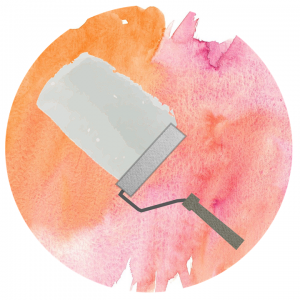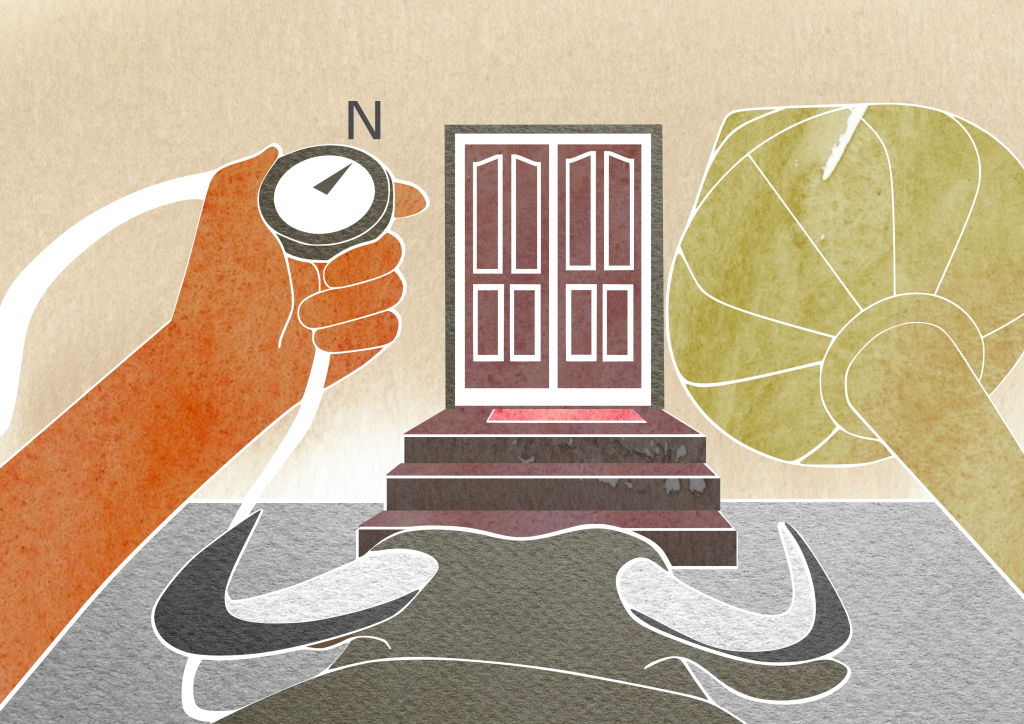South facing entrance will not kill you!
Student 1: Sashikala Ma’am… there are so many vAstu theories being floated around that leave most people confused and scared. As a vAstu practitioner, trained under Dr. Ganapathi Sthapati as well as a practicing architect, which is a rare and unique combination, can you please shed some light on a few common fears and perceptions regarding the subject?
Ma’am: Certainly. I will try to give a moderate view of the subject. Any extreme opinion leads to fear or false euphoria. To achieve a balanced state or a state of alignment has been the basic anchor of the dharma traditions.
Student 2: Yes Ma’am, not having this extreme opinion surely would be a refreshing change from the black and white view on the subject, and also helps one see vAstu as more than a rule book.
Let’s get started!
Student 1: Ma’am, I heard that according to ‘Vastu’, there can be a death in the household if the entrance is facing South? Is that true?
Ma’am: If it was true, then why have any war or prisons? Can we just not have all the enemies and prisoners live in South facing Entrance houses?
Death will come only when the time comes.
Each of the directions hold a specific meaning. This is known as cosmology and is a part of traditional wisdom from different parts of the world. Heroes walk to the East, South, West and North in myths to access certain gifts from nature. There is no good and bad direction talked about here. The East is the direction to understand the meaning of one’s birth and to gain knowledge, the West the direction to understand growth and health, the North is the direction to understand prosperity and South the direction to understand the meaning of death and rebirth with which comes the benefits of South as a direction of spiritual growth. They are all essential elements for the person to be in balance with the world of inner and outer reality.
Student 1: Oh, just because South refers to Death and Rebirth and is the direction of Yama, it has been misunderstood and also misinterpreted as causing death which brings fear into people’s minds.
Student 2: So, in that case, since East is also just representing its own specific meaning, it doesn’t actually make East facing entrance the best, Right?
M: It’s the default option. By and large the eastern entrance would bring about good energies because it brings in the light and warmth of the morning sun. But if the road is on the west of the plot, then entering from the east which would be the rear of the building and would be a bad decision, because it would affect the authority of the inhabitants adversely to enter from the back. Also it represents a lack of power and ownership. In any case there is a special calculation that is carried out for a new building called ShatAyAdi and this will offer the best direction specific to the owner or Yajaman.
morning sun. But if the road is on the west of the plot, then entering from the east which would be the rear of the building and would be a bad decision, because it would affect the authority of the inhabitants adversely to enter from the back. Also it represents a lack of power and ownership. In any case there is a special calculation that is carried out for a new building called ShatAyAdi and this will offer the best direction specific to the owner or Yajaman.
Student 2: That means since we should calculate the ShatAyAdi for the owners to decide the best direction for their building, generalising vAstu and saying this direction is good and the other is bad is wrong or absurd!
Student 1: Wow! That’s so interesting, so as per the Shastras all directions have their own meaning and can be beneficial depending on the individual’s shatAyAdi!
Ma’am: That’s right. But the tradition has not accepted the non-cardinal directions for the alignment of the building. Correction to obtain cardinal directions may not be possible in small plots particularly in sloping terrain. In that case we have to accept the existing directions and work with some corrective measures that have been recommended.
Student 1: So, when most so called ‘Vastu experts’ claim that something terrible will happen to us if certain ‘corrections’ are not made immediately at our space, should we believe them?
Student 2: What about the “Immediate good effects” that are promised once these corrections are done?
Student 1: Can changing vAstu alone change our lives?
Ma’am: Let us look at the basis of Sanatana Dharma (Hinduism as it is popularly known) to understand this idea of right and wrong vAstu. In the theoretical and philosophical framework of the dharma, right and wrong are not placed on a linear system of opposites. The gradation is more complex and allows for many meanings and possibilities to co-exist. For example Asanas in the system of Hatha yoga are not fixed. Based on the body capability of the person many variations can be practiced. Similarly Ayurveda speaks of understanding the individual prakruti or essential nature to be able to offer treatment through either medicine or diet. There is no single processor formula to be followed strictly. Unfortunately, in vAstu the practitioners have created very rigid boxes and use fear to control people. It is very obvious that the vAstu of the house one resides in is one many factors affecting a persons’ life. Therefore, projecting it as sole aspect of negativity and the source of all problems is definitely a money-making proposition.
There can be certain simple procedures to ascertain that the energies in the built form are conducive for wellness and balance. But just like there is no magical cure for illness, there cannot be a permanent state of happiness however hard we may try for it!! By promising this mythical state, people are definitely being misled.
Student 1: That is so true Ma’am… Some vAstu practitioners are creating fear and giving all kinds of strange solutions!
Student 2: Yes, like I have seen some residences which were painted in florescent colours for the sake of ‘Vastu’.
 Ma’am: This too is a new age gimmick. The traditional palette was Panchavarna or the 5 basic colours- red, yellow, green, blue black or krishna varna, and sky blue. All these colours were made with natural materials and were therefore very healing to the space. The houses were whitewashed, and sometimes turmeric powder was added to the lime wash and a beautiful golden colour was given to the walls. Moreover these colours were used sparingly in the residences of people as either borders or murals and frescos. Only in the temples these colours were used on walls vimanas and gopuras. Using bright colours indiscriminately, and that too made of toxic chemicals is not a traditional principle. In fact it goes against the idea of harmonising and balancing the dwelling with earth energies.
Ma’am: This too is a new age gimmick. The traditional palette was Panchavarna or the 5 basic colours- red, yellow, green, blue black or krishna varna, and sky blue. All these colours were made with natural materials and were therefore very healing to the space. The houses were whitewashed, and sometimes turmeric powder was added to the lime wash and a beautiful golden colour was given to the walls. Moreover these colours were used sparingly in the residences of people as either borders or murals and frescos. Only in the temples these colours were used on walls vimanas and gopuras. Using bright colours indiscriminately, and that too made of toxic chemicals is not a traditional principle. In fact it goes against the idea of harmonising and balancing the dwelling with earth energies.
Student 2: Hmmm… that’s so true… most times these structures stand out like sore sights destroying the harmony!
Student 1: Yes, those colours definitely look ridiculous, but what about the placement of rooms, Ma’am? Like, does the kitchen have to be ONLY in the South East and is it a must to have the master bed room in the South-West? Why do people insist on having an opening or door in the North- East?
Ma’am: These are also unnecessary rules that have been fixed in the built form by the practitioners. The shastras or texts have been written in various parts of the country and have specific reference to the terrain, thermal conditions, water table and wind/rain patterns of the locality. Not understanding any of this and applying simplistic formulae to every context is foolish as well as ineffective. One of the primary statements of the vAstu texts is to encourage the designer to become familiar with the environment and to design accordingly. Therefore, the placement of rooms has to be in accordance with the local rainfall, heat in the summer, wind directions and water tables. For example, heavy rainfall areas like Kerala usually had their kitchen in the NE with the well next to the kitchen. This geographical region also recommended the SW to be higher because the SW monsoon would have lashed into the building otherwise.
In general, the location of facilities will change based on the direction of the entrance, light and wind patterns, nature of the surrounding land and neighbourhood.
There is no one perfect solution.
Student 1: Interesting to know that we have options for the placement of rooms, otherwise all vAstu compliant houses would be same!
What about the water sumps, septic tanks, and bathrooms then?
Ma’am: A point to remember here is that in the traditional house toilets were kept outside the main building to its rear. Bathing rooms were accepted within the built form.
The reason is simple and very practical. Dealing with the effluent would have been complex and may have caused contamination of the water table. The location of water, sewage would have to be in relationship to the natural slope of the land, to facilitate the storage of rainwater and well water. Sewage was naturally recommended to the opposite side of the water source. Once again NE for water would have been the default location when many options are available.
Student 1: Wow… this mean there are actually no such rules for placement of toilets as being suggested by the vAstu experts? Are these some sort of marketing techniques?
Student 2: Indeed. It is quite an upsetting thought that this is happening at the expense of the reputation of our own tradition. These so called ‘small myths’ are making people perceive thousands of years of our ancient wisdom in a negative way.
Student 1: But could that also mean that these texts are outdated and insignificant in the present day and age?
Ma’am: The principles and philosophy enunciated in the texts as well as in the living examples of residences, palaces, warehouses, schools, choultries, villages and towns, and many others show us the appropriateness of the design and construction techniques. Who among us hasn’t marvelled at the beauty and comfort of a village house? What is important is to break up the components and understand the underlying order/harmony. Then it is possible to apply these principles to changing times and contexts
Student 2: Amazing! So vAstu is rightly still very relevant in our times… we just need a proper study and understanding of these principles…
Student 1: Perhaps it needs to be seen as a science which speaks about a way of life, and practiced much like Yoga, I suppose.
Ma’am: Yes, the science and principles of vAstu shastra is large and all encompassing. Our intention at Ritambhara is to teach people the traditions of vAstu and yoga, and to remove the fear inducing impact of the current teaching styles of these wonderful traditions. We welcome every kind of student to participate in our learning programmes.
Student 1: Thank you so much Ma’am… for clearing up so many myths about the vAstu of homes.
Student 2: There has always been a disconnect between modern Architecture and the traditional Indian science of vAstu, as though these are conflicting ideas and cannot go hand in hand.
We are fortunate to have this conversation with a practitioner who has acquired this holistic knowledge by years of practising the two together.
Student 1: In the next edition, we will demystify vAstu further by discussing the origins of vAstu, and the various aspects of site selection.
Watch video blog- https://youtu.be/-y_zhKqcYHo


 Anoop is a student of Yoga, an entrepreneur, a coach and a father of two young boys. He has led successful leadership stints in both the corporate and non-for-profit sectors. On encountering the country’s water/farmer crises at close quarters, he decided to pause and examine the impact various ‘isms’ – capitalism, colonialism, etc., were having on us as individuals, families, the society and the environment at large. This quest led him to formally engage with traditional Indic knowledge systems while also learning from the latest advances in science – about our physical and mental wellbeing, importance of body and mind work in healing trauma and the urgent need for a conscious rebuilding of family / work / social structures if we have to thrive individually and collectively. Insights, frameworks and processes gleaned from these on-going studies, an anchorage in his own personal practice and his wide-ranging experiences is what Anoop brings to facilitation/coaching spaces in Ritambhara and his various professional engagements.
Anoop is a student of Yoga, an entrepreneur, a coach and a father of two young boys. He has led successful leadership stints in both the corporate and non-for-profit sectors. On encountering the country’s water/farmer crises at close quarters, he decided to pause and examine the impact various ‘isms’ – capitalism, colonialism, etc., were having on us as individuals, families, the society and the environment at large. This quest led him to formally engage with traditional Indic knowledge systems while also learning from the latest advances in science – about our physical and mental wellbeing, importance of body and mind work in healing trauma and the urgent need for a conscious rebuilding of family / work / social structures if we have to thrive individually and collectively. Insights, frameworks and processes gleaned from these on-going studies, an anchorage in his own personal practice and his wide-ranging experiences is what Anoop brings to facilitation/coaching spaces in Ritambhara and his various professional engagements.
 Priya is a Yoga therapist in the Krishnamacharya tradition. She adapts Reiki & energy work, Vedic chanting, life coaching & Ayurvedic practices in her healing spaces. She is committed to nurturing collectives that have the praxis of Yoga at their heart.
Priya is a Yoga therapist in the Krishnamacharya tradition. She adapts Reiki & energy work, Vedic chanting, life coaching & Ayurvedic practices in her healing spaces. She is committed to nurturing collectives that have the praxis of Yoga at their heart. Anisha has been on an exploration to understand herself through yoga for the last 15years which led her to teaching yoga, yoga therapy and inner work through yoga.
Anisha has been on an exploration to understand herself through yoga for the last 15years which led her to teaching yoga, yoga therapy and inner work through yoga. Apoorva chanced upon Yoga in her early 20s. A spark was lit within and there was no turning back. Her exploration led her to the Krishnamacharya tradition more than a decade ago. Curious about human behaviour and what drives it, she was thrilled when her search ended (and also began) when she first came upon the Yoga Sutra, which illuminated a path towards answering many questions that had been held for a long time.
Apoorva chanced upon Yoga in her early 20s. A spark was lit within and there was no turning back. Her exploration led her to the Krishnamacharya tradition more than a decade ago. Curious about human behaviour and what drives it, she was thrilled when her search ended (and also began) when she first came upon the Yoga Sutra, which illuminated a path towards answering many questions that had been held for a long time. Anita is a yoga teacher and therapist in the tradition of Sri.T.Krishnamacarya and Sri T.K.V. Desikachar, a Reiki practitioner and a Life Coach. She is also the founder of Vishoka, a center for learning Indic and energy-based frameworks for living and healing. Her deep concern for human suffering and the problems of unsustainable living kept her on the path of seeking an integrated approach to looking at life, living, learning and healing.
Anita is a yoga teacher and therapist in the tradition of Sri.T.Krishnamacarya and Sri T.K.V. Desikachar, a Reiki practitioner and a Life Coach. She is also the founder of Vishoka, a center for learning Indic and energy-based frameworks for living and healing. Her deep concern for human suffering and the problems of unsustainable living kept her on the path of seeking an integrated approach to looking at life, living, learning and healing. Ankit is a seeker in the wisdom traditions of India. The core of his work includes creating dialogic spaces where people can look within and see the connection between their inner and outer lives. Inspired by the likes of Gandhi, Aurobindo, Vivekananda and Guru Gobind his experiments in service took him back to his roots in Punjab where he is creating a community-led model of higher education which is open, inclusive and accessible for all. Ritambhara for him is a space for engaging in a community which is committed to a DHramic life. He anchors his work of learning and leadership in the Antaranga Yoga Sadhana and the humanistic wisdom of Mahabharata.
Ankit is a seeker in the wisdom traditions of India. The core of his work includes creating dialogic spaces where people can look within and see the connection between their inner and outer lives. Inspired by the likes of Gandhi, Aurobindo, Vivekananda and Guru Gobind his experiments in service took him back to his roots in Punjab where he is creating a community-led model of higher education which is open, inclusive and accessible for all. Ritambhara for him is a space for engaging in a community which is committed to a DHramic life. He anchors his work of learning and leadership in the Antaranga Yoga Sadhana and the humanistic wisdom of Mahabharata.